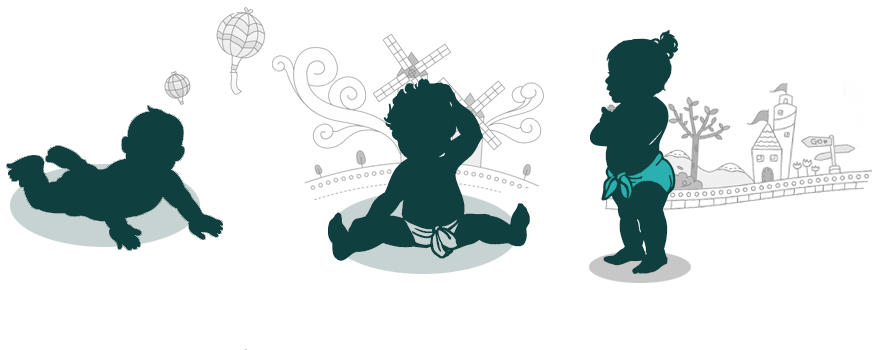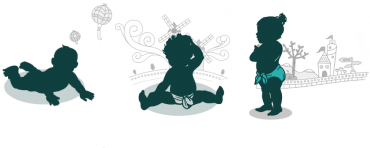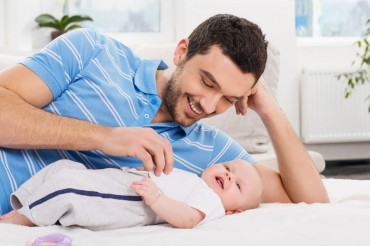Your child’s first year is full of first, but the most anticipated milestone is probably walking. When will those tiny toes take their first steps? Well, your little one is most likely to take her first steps between 9 and 15 months. Find out what to expect about this milestone.
Every child follows the same sequence of developmental stages
Here’s a broad timeline of the stages in order:
- Sitting up: At around 6 months, your baby will figure out how to use the muscles in his trunk to stay upright. Once your baby is sitting up, you can use pillows, boxes and sofa cushions to create obstacle courses for him. He may solve the problem of getting around by crawling, bottom shuffling, gliding on his stomach or rolling. Whatever he chooses will build his confidence, speed and agility.
- Pulling to a stand: 70 per cent of our body mass is from the hips on up, so our legs need a lot of strength to lift the torso. Your child is likely to try standing around 10 months.
- Cruising: The age varies but your child will eventually try moving from one piece of furniture to the next, looking for support.
Figuring out the mechanism of walking
To walk your child must figure out how to balance on one leg long enough to swing the other leg forward and shift the weight without falling.
In order to stand your child has to contract a lot of muscles. But to walk, she eventually needs to relax her hips and knees a bit. Initially, he will move around unsteadily as he gets used to his legs. To do so he will adopt a wide stance with outstretched arms. Encourage his efforts and remember to be patient. But it won’t be long before your child loosens up and is running around the house.
There’s little you can do to speed up this milestone
Push toys and pull toys as well as activity centers will not help your child walk any sooner. However, if your baby enjoys playing with these toys, let him play. Avoid walkers. Setting your child on the walker, before she is ready, will put undue stress on her limbs and may cause bow legs. Experts suggest that babies learn walking by understanding and watching how their legs move and understanding the steps. With a walker babies can’t see their lower body so overall using walker may delay the learning by a month. She may also attempt to run with the walker, tumble and hurt herself.
If your child is not trying to stand by 12 months or walking by 16 months, talk to your doctor. However, walking may be naturally delayed up to 18 months.
 Walking may be influenced by these factors
Walking may be influenced by these factors
- Size matters. A bigger baby may need more strength to pull upright than a smaller one and so may start walking later.
- Recurrent ear infections can throw off your baby’s balance and delay this milestone.
- If one of the parents started walking late, the child may show the same signs.
- Being an over cautious parent and not letting your baby explore may delay walking.
- A baby with an older sibling is likely to imitate what the big kid is doing and be motivated to walk earlier.
- If your baby has achieved another milestone first, such as talking, he may take a little longer to walk.
Barefoot is best
Your child is likely to learn to walk more easily if she doesn’t wear shoes. This is because bare feet allow direct contact with the floor. When you step outdoors, ofcourse, baby needs shoes. Look for a pair with flexible soles-you should be able to fold the shoe in half.
Expect some stops and starts
Sometimes baby may alternate between crawling and walking. Don’t stress about this. If your baby sees something across the room that requires her immediate attention, she prefers to crawl than to walk. She’s probably thinking that walking is going to take too long and I’ve got to get there NOW.
The next challenge now is to figure out how to stop
A new learner’s every step has more force than an adult’s because they don’t bend their knees or use a heel-toe motion, both of which absorb some of the impact. They haven’t figured out how to break their forward momentum by stopping with one foot and bringing the trailing foot to meet it. So they stop by falling. To make it easier for your child, remove unnecessary furniture that may hurt her.
Start childproofing your house
You probably set some amount of childproofing when your baby started crawling around the house. However, walking opens up new possibilities for your child. Make sure you block stairs and accessible windows as well as move furniture that can be tipped over. Consider padding sharp corners and put child locks on doors and drawers.






















































Comments